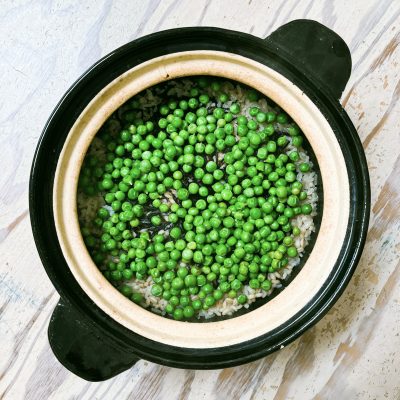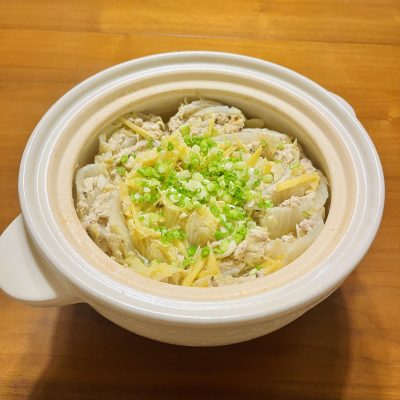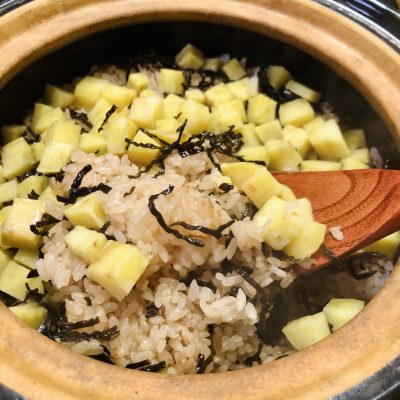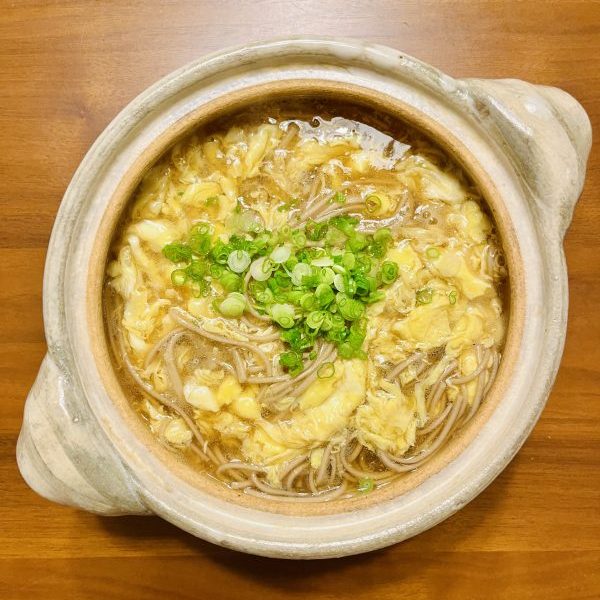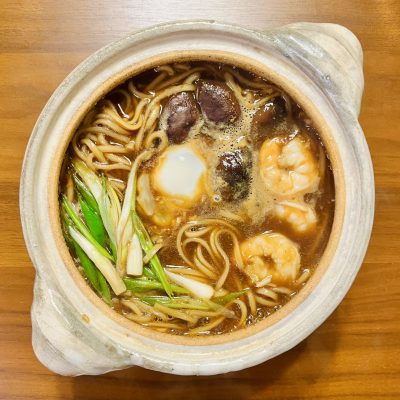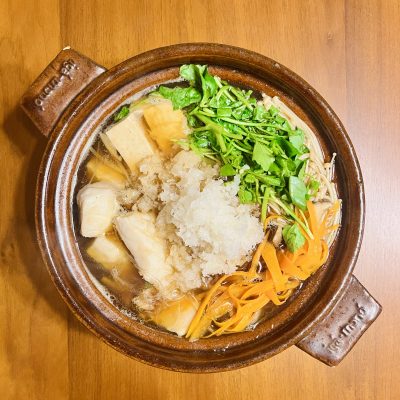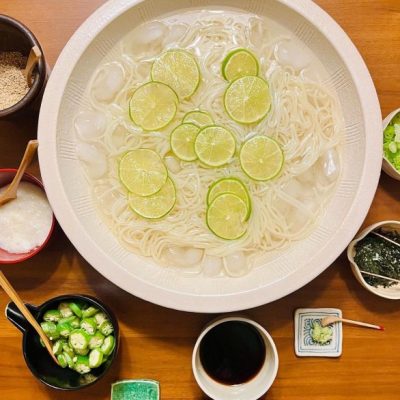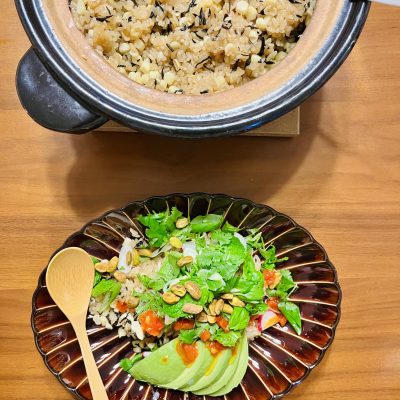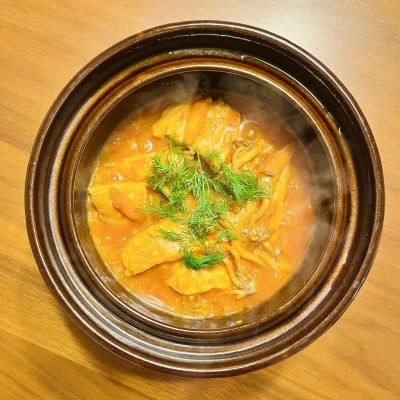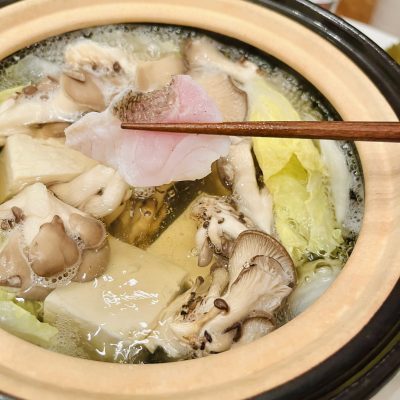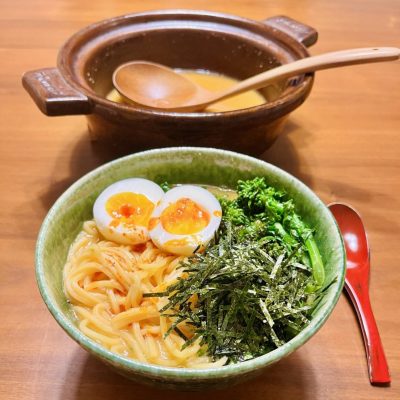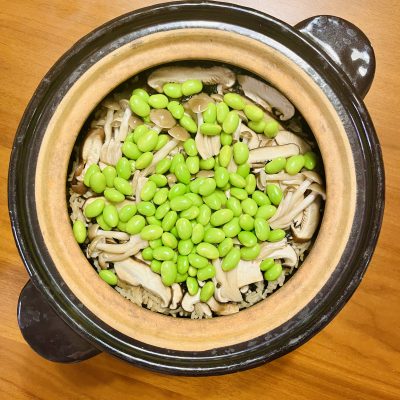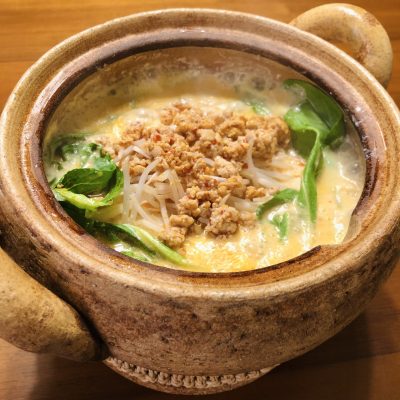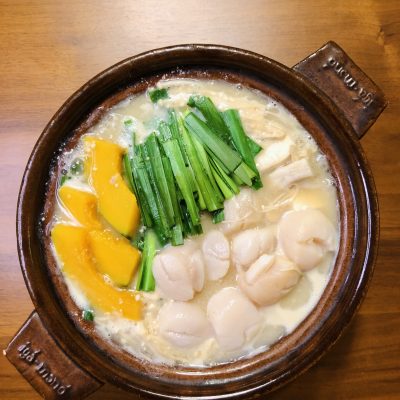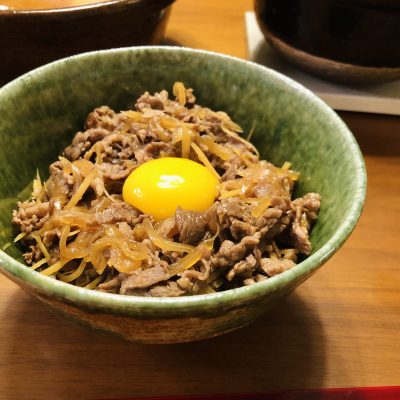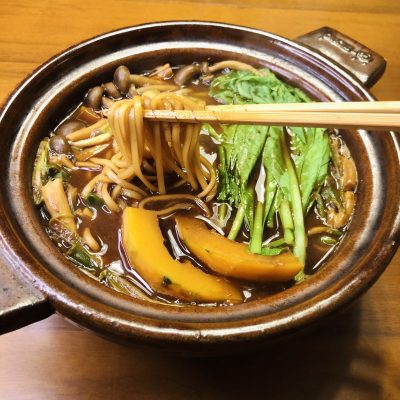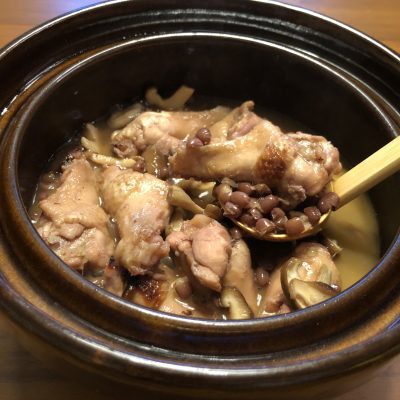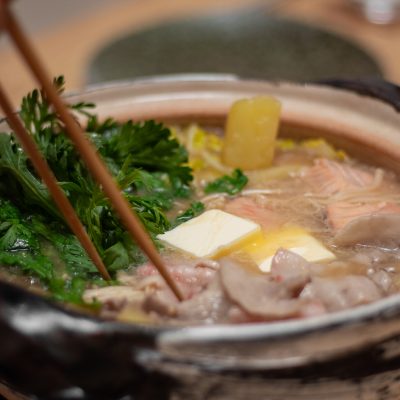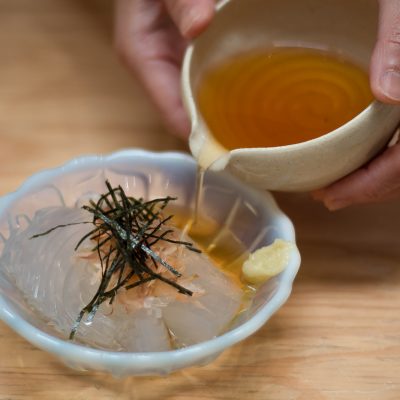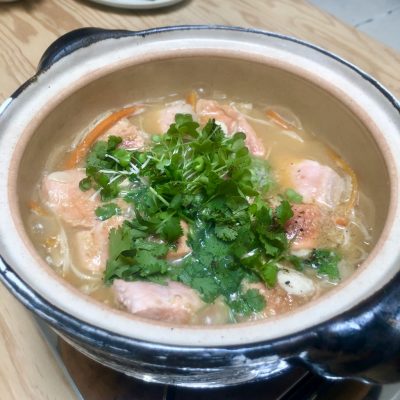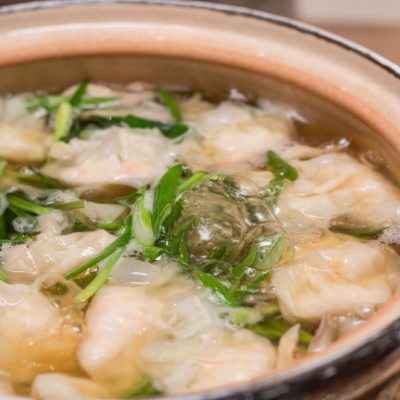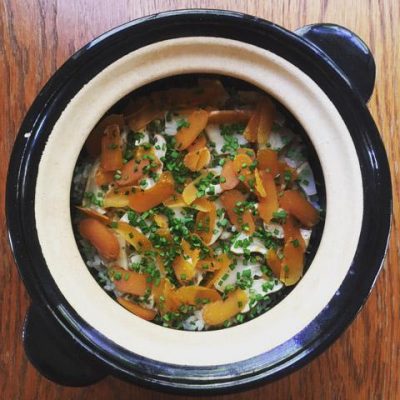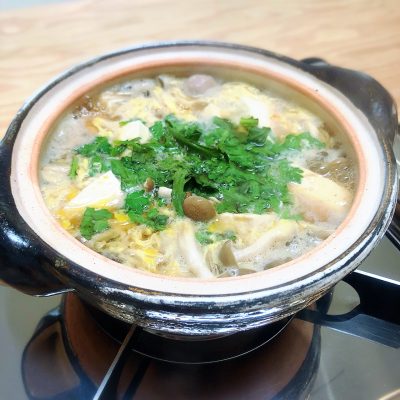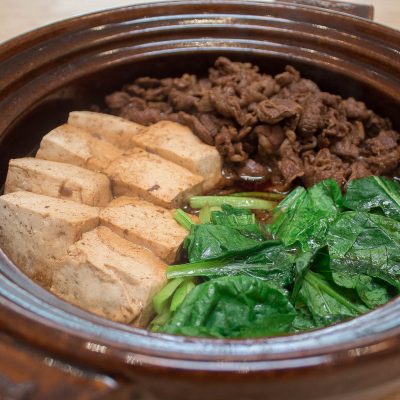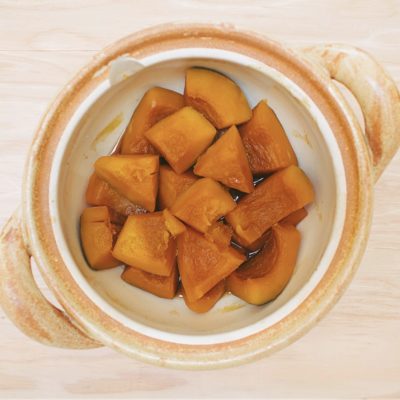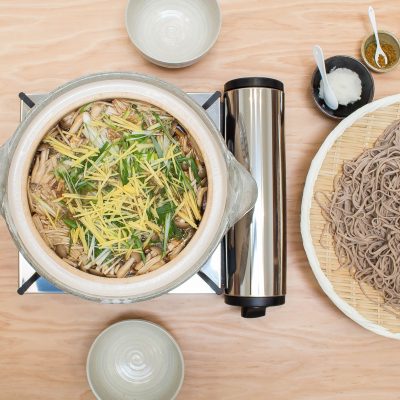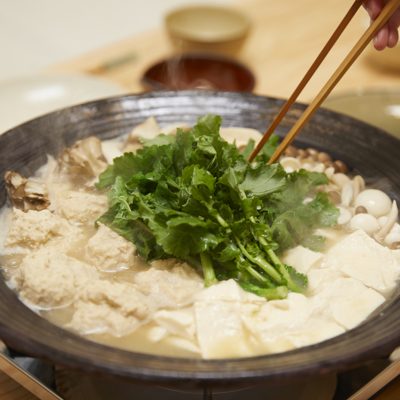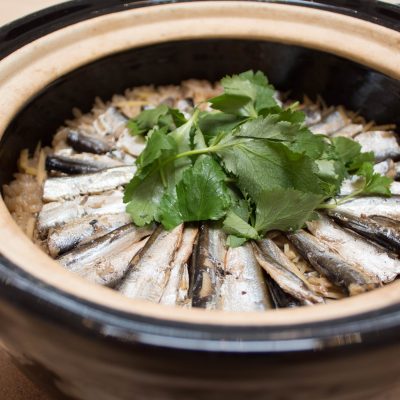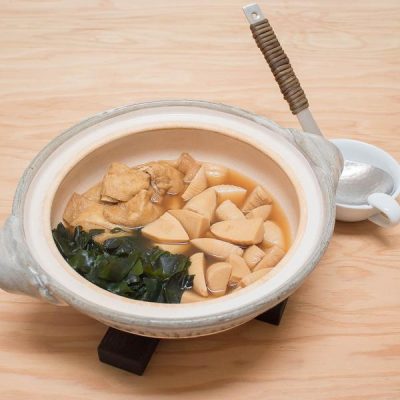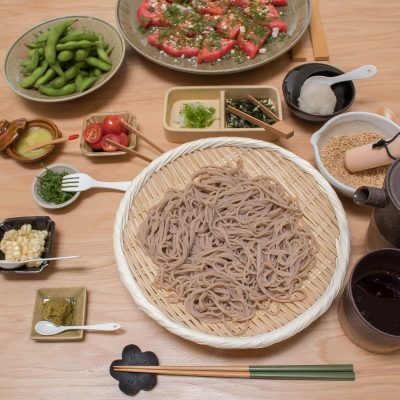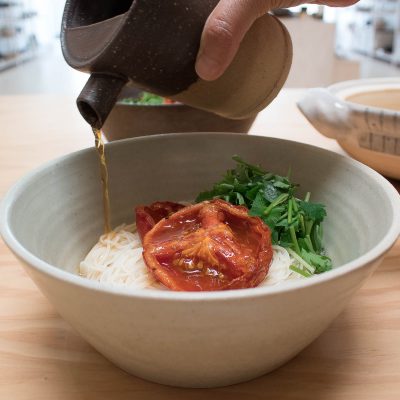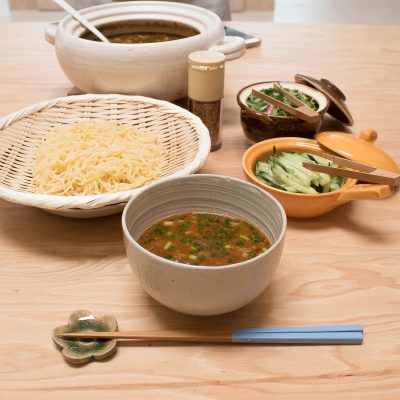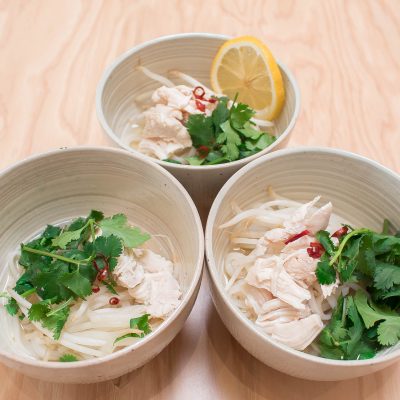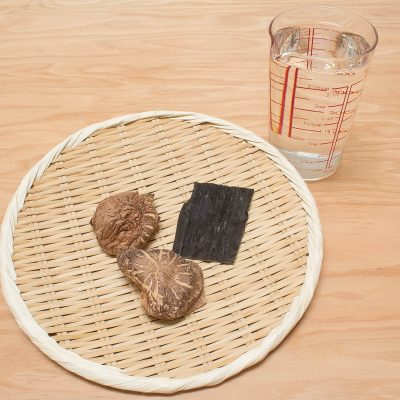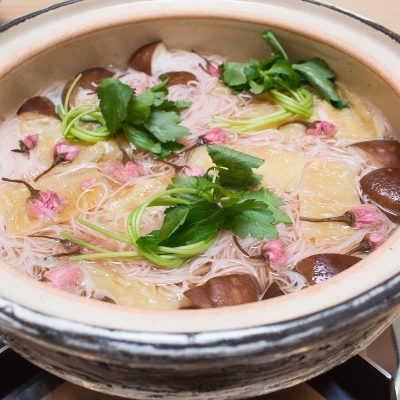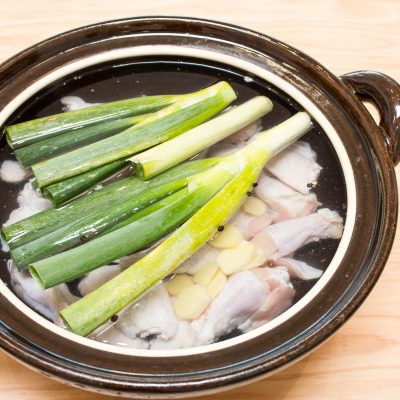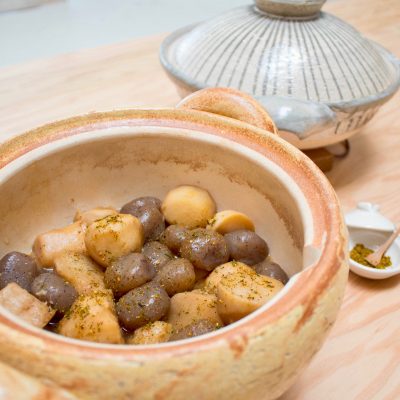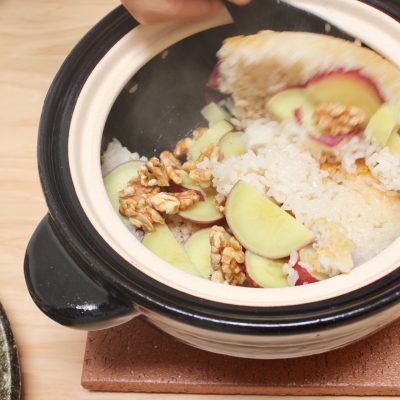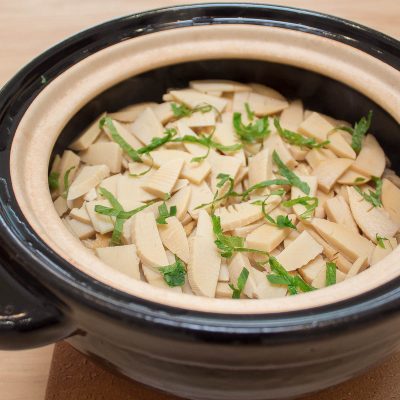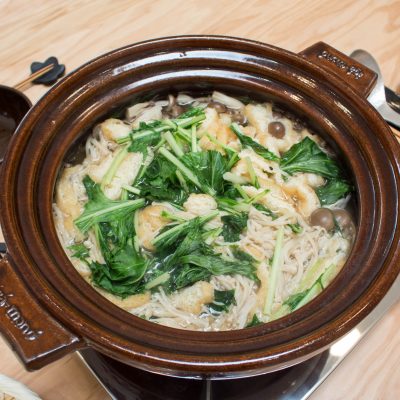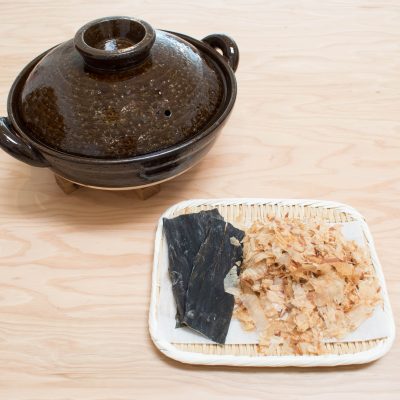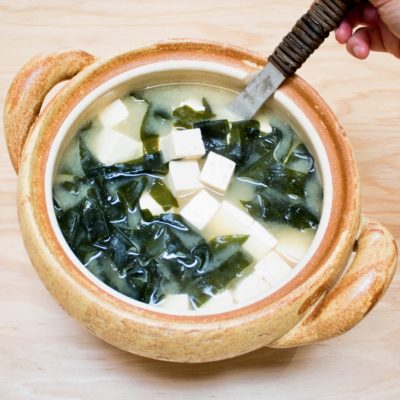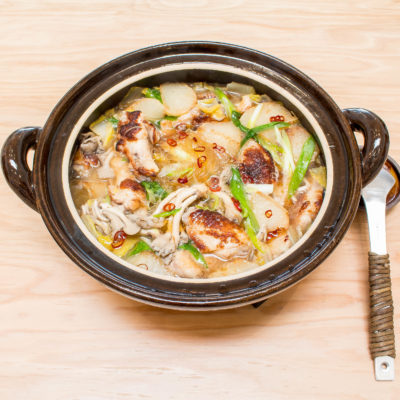My summer obsession of donabe corn rice has so many variations and this one is my new favorite! I never thought the combination of umeboshi (Japanese pickled plum) and corn make such great combination in flavors. I love making onigiri with this rice to take to picnic!
Tag Archives: Dashi
Yuba & Daikon Mille Feuille Nabe
Made with napa cabbage, yuba (tofu skin) and daikon, this new Mille Feuille Nabe is completely plant based, and no flavor is compromised compared to the other meat versions I have introduced. It’s rather, the flavor is so rich and the combination of yuba and miso broth brings heartiness. I can enjoy this dish all year round and my body feels so nourished!
I found delicious soft yuba by Hodo at a local Whole Foods. Yuba is not only nutritious dense, but it as the great texture and flavor. So, hope you can find it near you.
English Peas & Hijiki Mochi Mugi Rice
I can’t get enough of fresh English peas in the spring time. Here’s a slightly different version (and I would say even easier version) of my original English Peas and Hijiki Rice recipe, and this is equally delicious! Instead of using dashi stock, I add a content of a Vegetable Dashi packet directly to the water. The result is really umami rich and aromatic rice. Mochi Mugi barley adds nice texture and flavor, too. If you can’t find shelled fresh English peas, you can use frozen kind by thawing them before adding to the donabe.
Chicken & Tofu Mille Feuille Nabe
Here is a new variation to my “mille feuille” nabe recipes and this is a total keeper. It’s napa cabbage with ground chicken and tofu filling and tastes so rich and soothing. I season the dish with a Vegetable Dashi bag by simply tearing the bag and sprinkle the contents over the dish before cooking. This vegetable dashi bag is so convenient and the result is simply fantastic. The dish is packed with umami and already so tasty on its own, but I like to drizzle a small amount of soy sauce or a dab of Yuzu-Kosho.
Shio-Kombu & Sweet Potato Rice
Shio-kombu is one of the staple items in my pantry. It’s shredded seasoned kombu (kelp), and I like to toss them in a simple salad or use as a topping over rice, tofu, add to stir-fry, etc. It’s so versatile. My Ginger Shio-Kombu Rice recipe in the DONABE Cookbook is one of the most popular recipes among the donabe fans.
Here’s another donabe rice dish using shio-kombu. It’s Shio-Kombu & Satsuma-Imo Gohan. It’s a simple and delicious donabe rice, cooked with shio-kombu and Japanese sweet potato. As a “guilty pleasure”, after scooping the rice into a bowl, I like to top it with a small slice of butter (this time, I used this special cultured seaweed butter from France) Super good.
Spinach and Daikon Porridge
This is quick Spinach & Daikon Porridge I have been making often lately. It requires minimum prepping/ chopping. Instead of starting with cold water and rice, I boil vegetable dashi and add rice to cook. The texture of the rice turns smoother this way, and the flavor is amazing. The combination of daikon and spinach makes the dish taste even better.
Egg Drop Soba
Shrimp Miso Udon
Perfect for a cold season, this is Shrimp and Udon, Simmered in Dark Miso Broth. There is something about the deep simmering sound and look of the donabe noodles in miso broth. I make this dish repeatedly in the cold season. It’s a brilliant single serving one pot donabe meal which has rich satisfying flavors and keeps my body warm so nicely. I like to coat the shrimp in katakuriko (potato starch – you can omit or substitute with corn starch), as it helps shrimp turn really nice plump texture and also lightly thickens the broth. Also, shrimp cooks fast and adds nice flavors to the broth, but you’re welcome to omit or replace with your choice of topping.
Halibut & Daikon Hot Pot
Here’s my healthy seafood hot pot, Halibut Mizore Nabe – Halibut (or your choice of fish) is quickly simmered with vegetables and finished with a generous amount of grated daikon on top. With the addition of the glass noodles, this dish makes a very satisfying one pot donabe meal.
Cold Somen Noodle with Soy Dipping Sauce
Perfect for a hot summer day. Here’s one of my most basic cold noodle dishes which I never get tired of all my life. Donabe can make a perfect serving vessel, and it also makes a wonderful presentation, along with a variety of toppings.
For the dipping sauce, I have this staple soy-based sauce, Kaeshi, always in handy. Kaeshi is a multi-purpose sauce I use for so many things. I pour over noodle by mixing with water/ dashi, chicken, fish, salad, etc.
Beef Rice
Juicy donabe Beef Rice for your stamina. I used a block of American Wagyu hanger steak and thinly sliced by hand. By marinating the beef for a short time with sake, soy sauce and black sugar, the meat comes out so tender like you braised it! I also used some smoked soy sauce to complement the bold flavor but you can use only regular soy sauce, too. Donabe makes this dish so complete in flavor and texture, and it was just so delicious that I ate almost half of the pot. Happy Donabe Life!
Corn & Hijiki Rice with Olive Oil
This donabe dish is a variation of my other corn rice recipes and has been a big hit! This is 100% vegan and its flavor is really rich with corn, and fresh and aromatic with the addition of the extra virgin olive oil and mixed herbs. This dish makes a great one plate meal and tastes great at a warm or room temperature. Happy Donabe Life!
Salmon Stew in Sake Miso Tomato Sauce
This quick donabe dish is packed with umami. The combination of the miso, tomato paste and sake brings rich and aromatic flavors, and kanzuri adds the nice spicy nuance (you can make it without kanzuri if you want it to be more mild). This sauce is very versatile, so you can use it for other protein, etc. The thick-body and compact Roast Donabe is my choice of donabe for this dish (and see how the contents continue to simmer a while after it’s brought to a table) but classic-style donabe or any other donabe with enough capacity can work also.
Sea Bream Shabu Shabu
Spring really makes me want to eat Tai (sea bream) every day. I enjoy it in sashimi, carpaccio, sushi, etc. And, here’s another Tai dish I love, which is Tai Shabu. It’s basically a simple fish shabu shabu and always so good. If you can save enough broth, hope you enjoy the shime (finishing) noodle course, too.
Spicy Miso Butter Ramen
I love making this simple ramen dish for a quick one pot meal for one (or sometimes two). The broth is rich, spicy, yet not too heavy like you would experience at some ramen restaurants. I use Japanese dashi, but you can make it with chicken stock or any stock you like. A slice of butter is added to serve and elevates the flavor nicely. I like to make it so simple that my choice of toppings are rapini (broccoli rabe) and soft boiled egg. So, my dish is vegetarian, but you can enjoy with meat or any toppings you like.
Sesame and Saikyo Miso Hot Pot with Chicken Meatballs
This is an especially comforting donabe hot pot dish. Saikyo miso is a (naturally) sweet white miso, and the dashi based broth is flavored with sesame paste and Saikyo miso. Ginger-rich chicken tsukune (meatballs) are really fluffy and also adds depth to the broth. They are cooked along with different vegetables and just so satisfying. This is like a Japanese version of “chicken soup” to nourish your body and soul.
Steamed Pork and Cabbage Shabu Shabu
This steamed donabe dish is so tasty and nourishing. The thinly-sliced pork and cabbage always make a great flavor combination. The ingredients are simply steamed in a donabe steamer, Mushi Nabe for 4 – 5 minutes and served with pre-prepared ponzu and garlic miso dipping sauces. Feel free to substitute any ingredients to steam and enjoy!
Mixed Mushroom and Hijiki Rice
This is one of my regular donabe rice dishes. Mixed mushrooms, hijiki, and edamame – I love the combination of these flavors when they are mixed with rice. I use kombu and shiitake mushroom dashi, so this is a vegan dish but feel free to use your choice of dashi, stock or even just water. The dish come out aromatic and so satisfying every time.
Soymilk Tan Tan Nabe
Tan Tan Nabe, or Chinese-inspired miso-sesame broth with ground meat donabe hot pot is one of the most popular dishes from my DONABE Cookbook. Here is another variation of Tan Tan Nabe and it’s Soymilk Tan Tan Nabe. The soymilk adds the extra richness to the flavor of this dish, while the dish is quite healthy. The broth is so flavorful and soothing with a spicy kick. Also, it’s so easy to make. So, I love making this dish so much.
Dashi-Rich Fluffy Egg with Cheese
Among all the egg dishes I love, this is one of the most frequented egg dishes I make home. It’s Dashi-Rich Fluffy Egg with Cheese, made in a cute mini donabe, Petite Donabe. Unlike chawanmushi (steamed egg custard), this dish is direct-heated in a donbe over flame. So, this is similar to Korean gyeran-jjim, which I also love so much. Seasoned and beaten egg is added to boiling dashi all at once, and mixed with cheese. It takes just a few minutes to make this dish and is always so comforting! The fluffy egg and the soothing flavor of dashi make the dish so special. The individual-size donabe can distribute the heat evenly without burning the bottom. I like to stir in some shredded Swiss or gruyere cheese to cook with the egg for the gooey finish, but you can make it without the cheese also.
Scallop Hot Pot in Miso Broth
I love scallops so much and usually get large-size sashimi grade scallops to eat in so many different ways. One of the regular dishes is this simple miso-based hot pot in a donabe. It’s made so quickly, and the scallops release so much flavors to make the broth taste so rich and wonderful. I like blending two kinds of miso (both available at TOIRO) for extra complexity.
Beef Bowl
Gyu-Don, or beef bowl, is one of the most popular rice bowl dishes in Japan. It’s basically soy-flavored and slightly sweet simmered thin beef slices over rice. Here in LA where I live now, unless I take a trip to a Japanese market, I can’t get very thinly sliced beef at a regular market like in Japan. So, I usually get a block of boneless beef short rib and hand-slice it very thinly myself. I actually find this hand-cut version better than the other. The meat is simmered with onion in donabe for about half an hour and the result is such tender and flavorful beef. Donabe can bring out all the umami flavors cooked in it and become quite magical.
Hatcho Miso Udon Hot Pot
This dish can be made so quickly and create a balanced one-pot meal. I love the deep flavor of hatcho miso which is a dark miso. The flavor is almost chocolaty. Once the udon noodles are par-cooked, all the ingredients are cooked in one donabe. I like vegetables and tofu in this dish, so this dish is completely vegan. But, if you like, you can also enjoy this dish with an addition of meat. Chicken or duck slices are particularly good.
Azuki Chicken
I grew up eating Azuki (or adzuki) beans and love them in both sweet and savory dishes. They cook fast and very versatile. Here is my Azuki Chicken – extremely simple stew of these two main ingredients. This humble dish is so tasty and always warms my heart. When it’s cooked in donabe, the ingredients come out so tender and flavors become so deep. While any donabe with enough capacity can cook this dish wonderfully, I especially love using my Roast Donabe. This cute compact donabe has an extra thick body with a sturdy flat lid (with no vent) that helps create optimum insulation and moisture retention. And, as the name suggests, this donabe is great for roasting as this can be heated with no liquid inside.
Ginger Amazake Hot Pot
Ginger Amazake Nabe – a healthy and delicious donabe hot pot recipe and it’s one of my favorite hot pot dishes of the season to bring comfort and keep me warm! Hope you get to try it home. Feel free to substitute chicken with just vegetables or seafood, to make it your own way.
Miso Butter Hot Pot with Salmon and Pork
I’ve made this hot pot many times this season, both for myself and many other people. And, many of them asked me to share the recipe so they can make it home. The miso broth has two kinds of miso for complexity. The addition of butter at the end gives the beautiful depth in flavor.
Ishikari Nabe is originally a regional dish from Hokkaido (the northern island of Japan), and to me, the must “rule” to be called Ishikari Nabe is that the dish has to have salmon and potato in the miso broth. They taste so good together (especially with the butter added at the end)! That being said, the broth can go well with just about anything, so you can change around the ingredients to cook in it. When I cook for my vegan friends, I use kombu and shiitake dashi, and make it with tofu and different kinds of mushrooms (and no butter).
You can make the miso base (mixture of the miso, sake, mirin and soy sauce) in advance, and when it’s ready to serve, you can simply combine the miso base with dashi, and start cooking the ingredients in it at the table (or at in the kitchen stove and serve at the table).
For “shime” (finishing course), I love making ojiya (soupy porridge) in the remaining broth. Ramen is also great, too.
Salmon Roe & Grated Daikon Cold Udon
Here is another cold noodle dish with the classic topping combination of salmon roe and grated daikon (“ikura oroshi” – the other dish I posted with the combo is with cold soba and you can find a link here). This is served over udon and the broth is rich in dashi with a refreshing accent with yuzu juice and rice vinegar. The broth is so soothing, so you can drink it up, too.
You can make your own variations with different toppings such as chicken tender, roasted vegetables, wakame, eggs, or anything you like. I also like it with grilled eggplant!
Tokoroten Noodles with Dashi Vinegar Sauce
Tokoroten is a very popular and traditional Japanese dish and it’s essentially simple kanten (agar jelly), cut into noodles. Tokoroten itself doesn’t really have flavors, so it’s served with sauce and toppings. It’s served chilled, so people enjoy tokoroten especially during the summer. It’s often served at Japanese traditional tea/ dessert parlors, and there are also vendors specialized in serving only tokoroten! In Tokyo, where I am from, and most of eastern Japan, tokoroten is enjoyed with vinegar-soy based sauce, so the vinegar can help alleviate the fatigue while the cold temperature of the dish helps cooling down your body. Tokoroten itself has very few calories, so it’s very light yet quite satisfying. I’ve been wondering why this dish has never caught up its popularity in the US yet…so, I thought I should introduce this beloved Japanese humble dish here. With my version, the sauce includes dashi, so it’s mild with extra layer of umami flavors.
To cut the kanten into tokoroten noodles, I use a traditional tokoroten-tsuki (a traditional tool designed specifically for cutting tokoroten noodles). It’s not only very easy to use, but it’s really fun to cut noodles with this.
In Kansai (including Kyoto and Osaka) and many parts of western Japan, tokoroten is typically enjoyed with sweet syrup and served as a dessert. So, my friends from Kyoto say they think tokoroten with vinegar-soy sauce is so strange.
Salmon and Daikon in Garlic Butter Miso Sauce
Garlic, miso, and butter…they make a brilliant combination of flavors. The main ingredients to cook in the sauce are salmon (or you can use your choice of high quality rich flavor fish) and daikon, and they are piled up with a few other ingredients and quickly simmered in the sauce. The dish has a nice rich flavor with refreshing accent with the yuzu juice. I used cilantro and daikon sprouts as a garnish for this recipe, but dill is also a nice alternative.
Shrimp Wonton Hot Pot
This recipe is always popular among friends, and I often involve my guests in the wonton making. Everybody makes her/ his own shape of wontons. They are easy to shape and fun to do. My shrimp wontons don’t contain ground meat (such as pork or chicken), so you can really enjoy the natural sweet flavors of the shrimp and its bouncy texture.
I introduce two kinds of dipping sauces for this recipe. The Yuzu & Ayu Dipping Sauce has the beautiful aroma and it’s quite light. The Sesame Dipping Sauce has the nice rich flavor. The soup is also very tasty, so you can simply enjoy this dish just with Yuzu-Kosho or Kanzuri on the side.
Tuna Hot Pot
One day, a very good customer of ours stopped by at our shop to give us a block of fresh tuna he just caught from fishing in the Pacific Ocean. How sweet of him! It was super fresh sashimi quality, so we tried some as sashimi with different kinds of soy sauces we have, then for the remaining, I decided to make a donabe hot pot with it. Tuna hot pot in donabe is a popular dish in Japan, and it’s typically made as a combination with negi (Japanese green onion). It’s called Negi-Ma Nabe. The name is short for Negi (green onion) Maguro (tuna) Nabe (hot pot).
This dish is very simple, and all you need is good quality dashi, tuna (obviously!), green onion (for the name’s sake) and any other ingredients you like to add. I like it with my ponzu.
For the shime (finishing course), I like making quick ojiya (porridge) with freshly-cooked donabe rice.
Black Cod Hot Pot in Saikyo Miso & Soymilk Broth
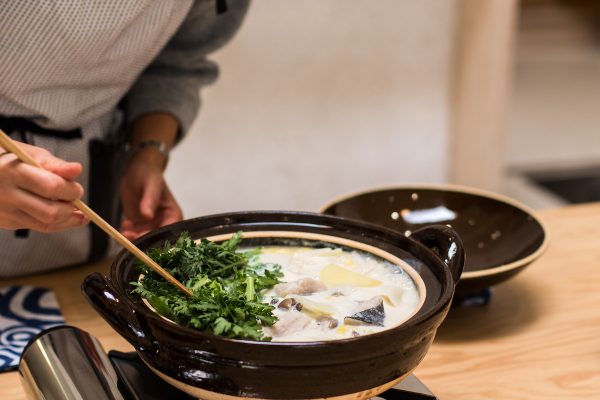
Saikyo miso is a traditional white miso from Kyoto, Japan. The color is pale and it has a natural umami-rich sweet flavor due to the higher content of koji rice (malted rice) in the miso. The sodium level is also much lower than other types of miso, so you can use a good amount of it to enjoy its rich flavor in a soup, etc. without making the dish too salty. This hot pot dish has the combination of dashi, soymilk, and Saikyo miso in the broth, so the flavor is rich and complex. Make sure to use the real Saikyo Miso from Kyoto and pure rich soymilk (with no additives) such as Banrai Soymilk.
Buttery fish like cod is perfect for this broth, other types of seafood or even chicken would certainly work in this dish, too.
Simmered Egg-Drop Chicken & Asparagus with Sansho Berries
This dish is a variation of Chicken & Tofu Hot Pot with Egg dish, and this dish is less soupy and the broth plays a role more as a seasoning for the ingredients. The combination of chicken, egg, and asparagus almost never go wrong, especially when asparagus is in high season in the spring time. The dish is topped with Salt-Pickled Sansho Berries, which bring such beautiful accent to the dish, but if you don’t have them, you can sprinkle some Sansho Powder, and it’s also very good for this dish.
Classic Chicken and Root Vegetable Stew
This is a traditional stew called Chikzen-ni, and is often served in a Japanese New Year meal, and one of my favorite New Year dishes since I was a child. The root vegetables such as burdock, lotus, carrot and sato-imo (taro) are cooked with konnyaku (yam jelly), dry shiitake, and chicken in dashi, and seasoned with soy sauce and black sugar. The flavor is so rich and you can really enjoy the nice earthy flavors.
When I serve this dish in the New Year, I cut the lotus and carrot into decorative shapes, but for any regular occasion, that’s not necessary.
Although I love the flavor of the chicken in Chikuzen-ni, this dish can easily be converted into a vegan dish by simply omit the chicken and use vegan dashi (i.e. kombu and dry shiitake dashi). You can also make it gluten-free by substituting the soy sauce and white tamari with tamari soy sauce.
Soba Noodle with Green Onion and Shiitake Mushroom
Soba noodle is one of the most beloved traditional Japanese foods in Japan. Many people enjoy soba dishes for lunch, and there are soba restaurants (many are hand-made) and stands everywhere in Japan. At home, soba makes a very popular meal. This is my quick soba noodle dish I love and make all the time for lunch, and I change the toppings according to what I have in my fridge or pantry. Sometimes, I serve with just mushrooms, wakame seaweed, or even completely plain with a dash of yuzu citrus zest. With the porous body of the donabe, I like that the broth stays hot until the end of the meal.
Bottarga and Matsutake Rice
When I’m lucky enough to have these special ingredients at the same time, I love making this dish. The earthy perfumy aroma of matsutake mushroom is so elegant and there is nothing equivalent to it. The umami-packed and slightly chewy character of karasumi (cured mullet roe, a Japanese delicacy, and it’s also a famous Italian ingredient, called bottarga in Italian.) You can substitute matsutake mushroom with a different kind of mushroom such as shimeji (although the aroma is very different, it’s still tasty) when matsutake is out of season. For karasumi, instead of slicing it, you can grate it to mix in the rice, too.
The dish shown in this photo is made in 1 rice-cup size Kamado-san.
Chicken & Tofu Hot Pot with Egg
This is my lazy-day but feel-good quick hot pot dish. I love my small size donabe so much, as it’s so handy to use, and I can make quick one-pot-meal for 1 to 2 people in a short time. In this dish, dashi (stock) is heated with soy sauce and mirin, then chicken, tofu, and mushrooms are added one after another to cook in the broth. Once everything is cooked through, eggs are drizzled in and cooked further (I like the soft stage). I used shungiku (chrysanthemum leaves) as a topping, but you can simply use thinly-sliced green onion or any of your choice of green topping. Enjoy with some sansho powder.
Tamari-Flavored Beef and Tofu Stew
Simple, quick, and satisfying, beef and tofu stew is a popular home dish in Japan. With an addition of komatsuna (Japanese spinach – you can substitute with regular spinach or other leafy greens), it makes a nutritiously balanced one-pot dish. I love using Tamari Soy Sauce for seasoning, as it gives a nice deep flavor, but you can also make it with regular soy sauce and it will still taste great. If you have any leftovers, I highly suggest you reheat it in a donabe (or a small pot), drizzle some whisked egg over it, then once the egg is at your desired consistency, pour the whole thing over the rice to make a beef and tofu rice bowl. Just so that I will have enough leftover the next day, I tend to make extra amounts of this dish.
Earthy Burdock Root Rice
Gobo (burdock) has a natural sweet earthy aroma, and I love the combination of minced gobo with rice for its hearty taste. Daikon leaves add a layer of earthy flavors and texture. If you can’t find daikon leaves, kale can work nicely, too. With this rice dish and a bowl of miso soup, it will make a happy donabe meal for me.
Japanese-style Simmered Kabocha
This is a classic Japanese home-style dish, and we love the full flavor of nutty kabocha with light seasoning of soy sauce, etc. This dish is almost ridiculously easy to make. Once you arrange the cut kabocha pieces with seasonings in a donabe, you heat it and let the donabe do the work for you. You don’t even need to stir the contents. With Miso-shiru Nabe, the delicate kabocha can cook so tender without falling apart.
Soba Noodle with Hot Mushroom Dipping Broth
I love making this dish especially when I am feeling a little weak and need something gentle for my stomach. Once you simmer mushrooms in a rich dashi-based broth, pour it into serving bowls and dip cold noodles in it to enjoy. The mushrooms adds the nice savory flavors to the broth. And, I love to use a generous amount of thinly-sliced ginger for both flavor and helping my body stay warm after having the dish. It’s so soothing and you can keep eating more and more. This dish is also nice to serve for a larger group. You can also change around the ingredients to cook in the broth for fun. For a vegan version, you can make with kombu dashi or vegetable dashi instead of kombu & bonito dashi.
Tofu & Spinach Hot Pot
Yu-Dofu (tofu hot pot) is a very simple and popular home dish in Japan. This version has addition of spinach and enoki mushrooms to boost nutrients and flavors. Yu-Dofu‘s best accompaniment is ponzu, and my quick daidai citrus ponzu tastes so refreshing and aromatic. Then, you can top the tofu with a generous amount of freshly-ground toasted sesame seeds in suribachi and surikogi (Japanese mortar and pestle), which is so nutty and aromatic. Kanzuri (chili condiment from Niigata, Japan) is another great condiment.
Chicken Meatball Hot Pot in Miso Broth
This simple miso-flavored hot pot is always so popular among my family and friends. By adding grated ginger and egg, the chicken meatballs becomes so fluffy and flavorful. The other main ingredients are tofu and mushrooms, which complete the dish to full satisfaction. The suggested shime (finishing course) to cook in the saved broth is udon or ramen.
Oil Sardine Rice
Canned oil sardines are great items to store in your pantry. It’s ready to use and rich in umami and nutrients. This sardine rice is so easy to make, as all you have to do is basically remove the sardines from the can and top on the rice with a few other ingredients to cook. Make sure to use a little amount of the oil from the can, as it’s infused with all the rich flavors of the sardines. I also highly recommend you sprinkle some Sansho Powder when serving, as the bright citrusy kick of the sansho with the rich sardine flavors work so well together. Oh, a little squeeze of fresh lemon over the rice is also nice, too.
I also like to cook this dish with the addition of Mochi Mugi barley. If you would like to cook with the Mochi Mugi, add a packet of Mochi Mugi to the rice and extra 1/2 cup (120 ml) of dashi and a pinch of salt in Step 1 of the recipe.
Simmered Bamboo Shoots in Dashi Broth
This is a very popular traditional Japanese dish in the spring, when fresh bamboo shoots and wakame seaweed are in the height of season. Bamboo brings sweet and tender characters, and the wakame is rich in mineral flavors. But, even if you can’t get such fresh ingredients in the season, with the increased availability and quality of pre-cooked bamboo and dried wakame, you can enjoy this dish all year round. I like to top it with a generous amount of shaved katsuobushi, as it gives extra rich flavor and makes the dish even more satisfying.
Cold Soba with Black Vinegar Dipping Sauce
Zaru Soba (cold soba with dipping sauce) has been a traditional fast food since Edo Period (1,603 – 1868) in Japan. From kids to elders, people in any social class can enjoy the fresh and smooth soba by quickly dipping in a sauce. While it’s a very popular quick dish for lunch, you can also find soba restaurants or posh izakaya establishments that serve soba as a final course after various small dishes to savor. I remember my late father ate soba for lunch 3 – 4 times a week because it was on of his very favorite foods. This version, instead of a typical soy sauce and mirin based sauce, I made it with an extra amount of dashi with a generous addition of brown rice black vinegar. The result is a very refreshing umami-packed dipping sauce, which you can even drink up (and it’s so good for you because of its high vinegar content).
Tomato Ginger Rice
Half-cut tomatoes are cooked together with rice in the donabe and becomes an extremely luscious dish. Tomatoes break so easily with a rice paddle and once you gently mix the contents, the beautiful red color coats the rice and imparts the sweet aroma of tomatoes and ginger. While this dish is completely vegan, even my meat-loving friends go crazy over it. (And, they fight over Naosco, the Yuzu-Kosho flavored hot sauce I make as a condiment for this dish.)
I love making this dish while the tomatoes are in season during summer. But, tomatoes don’t have to be very ripe to make this dish, so you can enjoy making this dish any time of the year.
Smoky Shoyu-Flavored Corn & Bacon Rice
Here’s another version of my corn rice; this one has a big, bold flavor with the addition of rendered bacon, Smoked Soy Sauce, and butter. This is a great dish to serve at a summer party, too. When I made this dish at an outdoor BBQ dinner one day, everybody went crazy and it was gone so quickly! Corn is so sweet and savory at the same time, with its nice smokey and nutty flavor. Although this addition is highly recommended, if you would like to omit the 16 Multi Mixed Grains, you can reduce the amount of the dashi by a tablespoon or so.
Cold Somen Noodle with Slow-Roasted Tomato
Here’s another variation of my recipe using slow-roasted tomatoes. After 4 – 5 hours in the oven, the tomatoes become so rich in umami flavors and very soft. So, I like to serve it very simply by topping them over the cold somen noodles and pouring a soy-flavored dashi broth over it. I like breaking the tomatoes with chopsticks and gently mix with the noodles as I eat, or you can coarsely chop the tomatoes before topping over the noodles, too.
The best thing is that both the tomatoes and broth can be prepared up to a few days in advance. So, once I make them for the next days, all I need to do is just boil the somen noodles and assemble them for a quick delicious meal.
Corn Rice
Corn rice is one of my favorite summer dishes to make. It’s simple and full of summer flavors. I like to cook with my cold-infused Kombu and Shiitake Mushroom Dashi, so I just let the dashi infuse half-day to overnight in the fridge and it’s ready to use. This dish is completely vegan, but you can cook with your choice of other stock (kombu & bonito dashi, chicken stock, etc.), too. For this recipe, I also added a packet of 16 Multi Mixed Grains (it’s so good), but if you would like to make it without it, you can reduce the amount of the dashi by a tablespoon or so. To add some kick to the dish, I like adding the Kanzuri Yuzu Sauce to the dish. You can top the rice with a small amount of the sauce or mix it in to the rice to enjoy. It’s quite addictive.
Cold Ramen with Spicy Pork & Sesame Dipping Broth
Cold ramen noodles with simmering hot and spicy broth with toppings create a wonderful dish to enjoy in the summer or all year round. The dipping broth is especially rich as it’s seasoned with hatcho miso (very dark miso made of 100% soybeans) with tamari soy sauce. But, if you don’t have either, you can simply substitute with quality red miso and dark soy sauce respectively and it would still be very tasty. You can also serve the broth cold, and it will be so refreshing and perfect to enjoy on a hot day.
Make Your Own Steamed Chicken Pho
Inspired by a popular Vietnamese noodle dish, this is my Japanese version of it and the dish totally takes advantage of the unique versatility of the donabe steamer, Mushi Nabe. I can do steaming and simmering in one pot, and it makes a great presentation at the table, too. I also love serving it hot pot style, so you can cook a small batch of noodles to serve at a time and continue to cook and serve until done. Then, you can choose and enjoy different toppings for every batch, if you like. You can be creative and serve with a wider variety of toppings, too. The broth has layers of umami flavors with the dashi, reserved chicken juice and Ayu fish sauce. This dish is always so comforting and fun at the same time. Instead of serving with a sliced lemon, you can also try with a splash of Pure Hon-Daidai Citrus Juice. The bright aroma of the daidai citrus will completely upgrade the dish to another level!
Chicken, Kabocha & Mochi Mugi Stew in Shio-Koji Broth
This hearty stew is so nourishing and tasty. The only seasoning is basically Liquid Shio-Koji, and this magical seasoning makes the chicken extra tender. With the addition of kabocha and Mochi Mugi barley, this dish tastes so complete and makes an ideal one pot meal. My body always feels so great after eating a big bowl of this stew. For this dish, I like making dashi (soup stock) with kombu and dried shiitake by soaking them in water for a few hours (to over night) in advance. They not only make the soup taste wonderful but also they can be sliced and added to cook in the stew to enjoy. But, you can also make this dish with chicken stock or vegetable stock and it will be delicious, too.
Kombu and Shiitake Mushroom Dashi
This is an easy cold-steep vegan dashi (Japanese stock). All you need to do is just combine the kombu (dry kelp) and dry shiitake mushrooms in a bowl and pour water. After infusing overnight, the rich vegan dashi is ready.
Somen Noodle and Cherry Blossoms Hot Pot
I always get so excited when the spring season comes and make a lot of cherry blossom-theme dishes. This is one of them and I add salt-preserved sakura (cherry blossom) flowers to the broth, and I even use the pink sakura-flavored somennoodles made from flour and sakura from Japan. The aroma of sakura in this dish is just so beautiful. But, don’t worry if you don’t have any of them! You can totally make the delicious somen hot pot without the sakura flavors, and this dish can be enjoyed all year round. You can also change the other ingredients to cook with the noodles by using different kinds of mushrooms or tofu, if you like. It’s so gentle on the stomach and always comforting.
Dashi-Rich Steam-Fry Hiramasa and Napa Cabbage
Simply assembled hiramasa (amberjack) with napa cabbage and shimeji mushrooms taste so pure and satisfying with the rich flavor of the dashi broth. The broth’s umami level is boosted with the addition of ayu fish sauce (I call this “magic essence”). Hiramasa can be substituted with yellowtail, sea bass, snapper, salmon, or any buttery fish filet. I like to serve this dish with plain donabe rice (white or brown).
Clam Rice
This is a popular Japanese dish and we love it especially in the spring time when the clams are in the top season. Plump sake-steamed clams are folded in to the donabe rice, cooked with the combination of clam juice (from steaming) and dashi. My version uses extra amount (almost double or more) of clams compared to normal clam rice recipes, because I like to really enjoy the meaty clams in the rice! But, you can also make the dish with less amount of clams, and the dish would still taste delicious.
I also like to cook this dish with the addition of Mochi Mugi barley. If you would like to cook with the Mochi Mugi, add a packet of Mochi Mugi to the rice and extra 1/2 cup (120 ml) of dashi and a pinch of salt in Step 3 of the recipe.
Egg Drop Vegetable Soup
This soup is full of flavors and very satisfying. The addition of the black vinegar gives the nice umami-rich accent to the dish. The fluffy egg with vegetables make wonderful layers of textures, too. I like to sprinkle some sansho powder to the soup for extra kick, but it’s totally optional.
Japanese Chicken Stock
Relatively inexpensive chicken wings can make really rich and flavorful stock, as the wings have a lot of bones and joints where the richest flavors are released from. In just 20 minutes of simmering plus resting time, the rich tori dashi is ready. I usually make a large amount, so I can use it for a couple of different dishes, but if your donabe is medium or smaller size, you can adjust the recipe about by cutting by half or so. The bonus of making this stock is the leftover chicken. It’s still flavorful, so I like to make a side dish with it.
Make Your Own Shoyu Ramen Hot Pot
Making ramen is easy and fun, especially if you cook and serve as donabe hot pot right at the table. I like adding the chopped nira (garlic chives) to the ramen right before serving, but if you can’t find nira, you can substitute with thinly-sliced green onion and serve as a topping, instead. Enjoy with a couple of simple toppings or a make a platter of a wide selection of toppings to choose from for fun.
Taro and Konnyaku Stew
Sato-imo (Japanese taro) is one of my favorite ingredients in the fall to winter seasons. When it’s simmered in broth, it becomes creamy inside and flavor becomes rich. This goes well with konnyaku (yam jelly) and makes such a hearty healthy treat. I used ball shape konnyaku in this recipe, but you can just get a block of konnyaku and tear into bite-size pieces by hand, so they will absorb the flavors from the broth well. This dish tastes delicious right when it’s ready, but I like it even more after a few hours of resting. If you let it rest for a few hours or longer. You can reheat it or serve at room temperature.
Sweet Potato & Walnut Rice
Satsuma-imo (Japanese sweet potato) and roasted walnuts bring rich earth and sweet flavors to this dish.
Bamboo Shoot Rice
Spring is the high season for freshly foraged bamboo shoots and they taste really wonderful. They are crisp tender and full of sweet spring flavors. In Japan, people enjoy so many different kinds of bamboo dishes while the fresh shoots are in season. Bamboo shoot rice used to be my favorite bamboo dish my mom made when I was a child. This dish also tastes great at room temperature or even cold. If fresh bamboo shoots are not available, pre-cooked bamboo shoot can be found at Japanese grocery stores and they are sold all year round.
Egg-topped Garlic Chives & Shiitake
Nira (garlic chives) and shiitake mushrooms are quickly simmered in kombu & shiitake dashi-based broth, then finished with eggs. I like the very soft and slightly runny stage of the eggs, so let it cook for a short time once the eggs are added. This dish is great as an appetizer (served as a soup), side dish, or I also like to pour over rice. If you can’t find nira, you can substitute it with spinach or pea shoot. You can also add rehydrated dry shiitake used to make the dashi for extra flavor and texture.
Mushroom & Mizuna Hot Pot
This simple vegan hot pot is so rich in flavor and satisfying. I like to slice the abura-age very thin, as these slices soak up the broth and taste like juicy noodles. If you don’t have access to abura-age, thinly-sliced tofu can work, too. The key for the rich broth flavor is to add the mushrooms before heating up the kombu-soaked water, so the mushrooms release all the umami flavors during the slow heating process. For the shime (finishing course), I like to add udon noodles to the remaining broth, but soba is also good, too.
Basic Japanese Stock – Kombu and Bonito Dashi
Dashi is the mother of Japanese dishes. This is the basic awase dashi (dashi made of two ingredients – kombu and katsuobushi), and besides knowing how to make it right, using the high quality ingredients is extremely important to make good dashi. Here’s my basic dashi making process. It’s very simple and straightforward, and the result is always superb. If you let the kombu sun-bathe (just leave it in a basket under the direct sunlight) for about 30 minutes before soaking in water, it would help increasing the vitamin D and umami levels of the dashi.
Tofu and Wakame Miso Soup
Tofu and wakame miso soup is such a classic Japanese soup, and it’s one of my ultimate comfort foods. Because Miso-shiru Nabe has such a high heat retention ability, the soup stays very hot for a long time after turning off the heat. Make sure to turn off the heat as soon as you add the miso, and never boil the soup, so you can really enjoy the most aromatic stage of the miso. If you have access, salt-preserved wakame (or sometimes it’s called “fresh wakame“) is recommended as it gives the nice fresh texture to the soup, and you can add it at the very end to the donabe or add to your bowl after the soup is poured into individual bowls.
Chicken Wings & Daikon Hot Pot
Chicken wings and daikon are a classic combination in Japanese cooking. By pan-frying these ingredients before adding to the broth, the flavor of this simple dish enhances dramatically. Because the chicken is already marinated in shio-koji, this dish doesn’t require much more seasoning. Feel free to use fingers to savor the wings, as it’s part of the fun of this dish!
Japanese Beef & Potato Stew
This hearty beef and potato stew is such a popular Japanese home dish among people from little kids to elders. While there are countless variations, for my nikujaga, I like to caramelize the onion before adding other ingredients. The onion gives nice rich layer of umami flavor to the dish. Miso-shiru Nabe always makes the perfect caramelized onion without having to constantly sauté it. I also add a lot of thinly sliced gingers for the accent.



